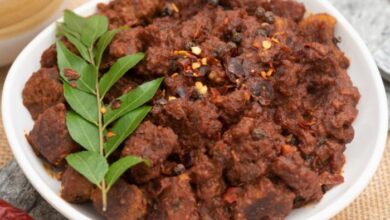
Chicken Thigh Meat Stir Fry: A Flavorful and Versatile Dish
Chicken thigh meat stir fry is a culinary masterpiece that tantalizes taste buds with its vibrant flavors and textures. This dish, a beloved staple in many cuisines, showcases the versatility of chicken thighs, a cut that delivers both juicy tenderness and rich flavor.
The art of stir-frying elevates the chicken thighs, allowing them to absorb the essence of aromatic sauces and crisp vegetables, creating a symphony of tastes that is both satisfying and unforgettable.
Whether you’re a seasoned chef or a kitchen novice, the allure of chicken thigh stir fry lies in its simplicity and adaptability. The recipe can be customized to suit your preferences, incorporating a wide range of ingredients and cooking techniques.
From classic Asian-inspired stir-fries to more contemporary twists, the possibilities are endless. Let’s delve into the secrets of creating a truly exceptional chicken thigh stir fry, exploring the best practices for preparation, cooking, and presentation.
Chicken Thigh Meat
Chicken thighs are a popular choice for stir-fry dishes, and for good reason. They offer a delicious flavor and tender texture, making them a versatile ingredient that can be used in a wide variety of recipes.
Advantages of Chicken Thighs
Chicken thighs are a preferred choice for stir-fries due to their higher fat content compared to chicken breasts. This fat content helps to keep the meat moist and flavorful during cooking, preventing it from becoming dry and tough.
Bone-In vs. Boneless Chicken Thighs
The choice between bone-in and boneless chicken thighs for stir-fry depends on personal preference and the desired outcome. Bone-in chicken thighs offer a richer flavor and more intense taste due to the presence of the bone. The bone also helps to keep the meat moist during cooking.
However, bone-in thighs require a bit more preparation, as they need to be deboned before cooking. Boneless chicken thighs are easier to cook and require less preparation time. They are also a good choice for stir-fries where the meat needs to be cut into smaller pieces.
Chicken Thighs vs. Other Chicken Cuts
Chicken thighs have a distinct flavor profile compared to other cuts of chicken. They are typically more flavorful and tender than chicken breasts, which can sometimes become dry and tough during cooking. Chicken legs also offer a similar flavor and texture to chicken thighs.Chicken thighs are a versatile and flavorful ingredient that can be used in a variety of stir-fry dishes.
Chicken thigh meat stir fry is a classic for a reason – it’s quick, versatile, and always satisfying. But sometimes, I crave something a little more comforting, like a hearty lasagna. If you’re looking for a quick and easy alternative, check out this quick and easy skillet lasagna recipe – it’s perfect for weeknights! Of course, nothing beats a good chicken stir fry with a side of rice for a light and flavorful meal.
Whether you prefer bone-in or boneless, chicken thighs are a delicious and satisfying choice for your next stir-fry.
Preparing Chicken Thighs for Stir-Fry

Chicken thighs are a great choice for stir-fry because they are flavorful and stay moist even when cooked quickly. Here’s a guide on how to prepare them perfectly:
Trimming and Cutting Chicken Thighs
Before cooking, trimming and cutting chicken thighs appropriately is essential. This ensures even cooking and prevents the meat from becoming tough.
- Remove Excess Fat:Trim away any excess fat from the chicken thighs, especially around the skin. This will help reduce the amount of grease in your stir-fry.
- Cut into Bite-Sized Pieces:For stir-fry, cut the chicken thighs into bite-sized pieces, about 1-inch thick. This ensures that the chicken cooks evenly and quickly.
- Consider Bone-in or Boneless:You can use bone-in or boneless chicken thighs for stir-fry. Bone-in thighs add extra flavor, but boneless thighs are easier to cut and cook.
Marinating Chicken Thighs
Marinating chicken thighs is a great way to enhance their flavor and tenderness. It allows the flavors to penetrate the meat, resulting in a more delicious stir-fry.
- Classic Marinades:Simple marinades like soy sauce, ginger, garlic, and black pepper are classic choices for chicken stir-fry. These ingredients add savory and aromatic flavors to the meat.
- Sweet and Savory Marinades:For a sweeter and more complex flavor, consider using honey, brown sugar, or other sweet ingredients in your marinade. This combination creates a balance of sweet and savory flavors.
- Spicy Marinades:If you prefer a spicy kick, add chili peppers, sriracha sauce, or other hot sauces to your marinade. This will add a fiery punch to your stir-fry.
Cooking Chicken Thighs
Cooking chicken thighs for stir-fry requires a quick and efficient method to ensure they are cooked through and tender.
- High Heat:Stir-fry chicken thighs over high heat. This helps to seal in the juices and prevents the meat from becoming dry.
- Stir Frequently:Stir the chicken frequently while cooking to ensure that it cooks evenly and doesn’t stick to the pan.
- Cook Until No Longer Pink:Cook the chicken until it is no longer pink in the center. This indicates that it is cooked through and safe to eat.
Stir-Fry Sauce Variations
The heart of any stir-fry is the sauce. It’s what binds all the flavors together and adds that signature umami kick. While a simple soy sauce and oyster sauce combination is a classic, there’s a whole world of stir-fry sauce variations waiting to be explored.
Let’s dive into the diverse flavors and ingredients that can elevate your chicken thigh stir-fry.
Chicken thigh meat stir fry is a classic for a reason – it’s flavorful, versatile, and cooks up quickly. But sometimes, you want something a little more hands-off. That’s where easy baked chicken thighs come in. Check out this recipe for easy baked chicken thighs for a simple, flavorful dish.
Once your chicken is baked, you can easily shred it and toss it into your favorite stir-fry for a delicious and convenient meal.
Types of Stir-Fry Sauce
The type of sauce you choose can drastically alter the taste and texture of your stir-fry. Here’s a breakdown of common stir-fry sauce types:
- Soy Sauce-Based:This is the most fundamental stir-fry sauce. It’s typically a blend of soy sauce, oyster sauce, sugar, and sometimes a touch of cornstarch for thickening. This sauce is versatile and works well with a variety of ingredients, including chicken thighs.
- Sweet and Sour:As the name suggests, this sauce combines sweet and sour notes. Common ingredients include ketchup, vinegar, sugar, and cornstarch. It’s a popular choice for stir-fries with a tangy kick.
- Honey Garlic:This sauce is a delightful blend of honey, garlic, soy sauce, and sometimes a touch of ginger. It creates a sweet and savory sauce with a distinct garlicky flavor. It pairs exceptionally well with chicken thighs.
- Peanut Sauce:A popular choice for Asian-inspired stir-fries, this sauce is made with peanut butter, soy sauce, hoisin sauce, and sometimes a touch of ginger and garlic. It offers a rich, nutty flavor that complements chicken thighs perfectly.
- Teriyaki:This sauce, a staple in Japanese cuisine, features a combination of soy sauce, mirin (sweet rice wine), sugar, and sometimes ginger. It’s known for its glossy finish and sweet, savory flavor. It’s an excellent choice for chicken thigh stir-fries, adding a touch of Japanese flair.
Stir-Fry Sauce Comparison Table, Chicken thigh meat stir fry
To better understand the differences between these sauce variations, let’s compare them in a table:
| Sauce Type | Key Ingredients | Flavor Profile | Cooking Method |
|---|---|---|---|
| Soy Sauce-Based | Soy sauce, oyster sauce, sugar, cornstarch | Savory, umami, slightly sweet | Combine ingredients and whisk until smooth. Heat over medium heat until thickened. |
| Sweet and Sour | Ketchup, vinegar, sugar, cornstarch | Sweet, sour, tangy | Combine ingredients and whisk until smooth. Heat over medium heat until thickened. |
| Honey Garlic | Honey, garlic, soy sauce, ginger (optional) | Sweet, savory, garlicky | Combine ingredients and whisk until smooth. Heat over medium heat until thickened. |
| Peanut Sauce | Peanut butter, soy sauce, hoisin sauce, ginger (optional), garlic (optional) | Rich, nutty, savory | Combine ingredients and whisk until smooth. Heat over medium heat until thickened. |
| Teriyaki | Soy sauce, mirin, sugar, ginger (optional) | Sweet, savory, slightly salty | Combine ingredients and whisk until smooth. Heat over medium heat until thickened. |
Essential Stir-Fry Vegetables: Chicken Thigh Meat Stir Fry
A stir-fry is all about the interplay of flavors and textures. While chicken thighs are the star of the show, the supporting cast of vegetables plays a crucial role in creating a truly satisfying dish. Choosing the right vegetables and knowing how to cook them to perfection is key.
Choosing the Right Vegetables
The best stir-fry vegetables are those that hold up well to high heat and offer a variety of textures and flavors. Some popular choices include:
- Bell Peppers:These vibrant vegetables add sweetness and a satisfying crunch. Red bell peppers have a slightly sweeter flavor than green bell peppers.
- Broccoli:Broccoli florets offer a pleasant bite and hold their shape well during stir-frying.
- Carrots:Carrots add a touch of sweetness and a pleasing crunch.
- Celery:Celery adds a refreshing, slightly bitter note and a satisfying crunch.
- Mushrooms:Mushrooms offer a meaty texture and earthy flavor that complements the chicken beautifully.
- Snap Peas:Snap peas add a delicate sweetness and a delightful crunch.
- Snow Peas:Snow peas offer a slightly sweeter flavor and a tender texture.
- Onion:Onions add a sharp, pungent flavor that balances the sweetness of other vegetables.
Cooking Times for Vegetables
The key to a successful stir-fry is cooking the vegetables quickly and evenly. Here’s a general guide to cooking times for common stir-fry vegetables:
- Bell Peppers:2-3 minutes
- Broccoli:3-4 minutes
- Carrots:3-4 minutes
- Celery:2-3 minutes
- Mushrooms:3-4 minutes
- Snap Peas:1-2 minutes
- Snow Peas:1-2 minutes
- Onion:2-3 minutes
Cutting and Prepping Vegetables
Properly cutting and prepping your vegetables is crucial for a successful stir-fry. Here are some tips:
- Cut Vegetables Uniformly:This ensures even cooking and prevents some vegetables from becoming overcooked while others remain undercooked.
- Cut Vegetables into Bite-Sized Pieces:This makes them easier to eat and ensures they cook quickly and evenly.
- Prepare Vegetables Ahead of Time:This will save you time when you’re ready to stir-fry.
Stir-Fry Techniques
Stir-frying is a fast-paced cooking method that relies on high heat and quick movements to create tender, flavorful dishes. Mastering the art of stir-frying requires understanding the key techniques and using the right tools. This section will delve into the techniques for stir-frying chicken thighs and vegetables, along with tips for creating a balanced and flavorful stir-fry.
Stir-Frying Chicken Thighs
Stir-frying chicken thighs requires a specific approach to ensure they cook evenly and remain juicy. Here’s a step-by-step guide:
- Cut the chicken thighs into bite-sized pieces:This allows for faster cooking and ensures the chicken cooks evenly.
- Marinate the chicken:Marinating the chicken thighs in a mixture of soy sauce, ginger, garlic, and cornstarch helps tenderize the meat and adds flavor.
- Heat the wok or skillet over high heat:A hot wok or skillet is crucial for achieving the desired sear on the chicken.
- Add oil to the wok:Use a high-heat oil like vegetable or peanut oil.
- Add the chicken to the wok:Avoid overcrowding the wok. Cook the chicken in batches if necessary.
- Stir-fry the chicken:Stir-fry the chicken for about 3-5 minutes, or until browned and cooked through.
- Remove the chicken from the wok:Set the cooked chicken aside.
Stir-Frying Vegetables
Stir-frying vegetables requires careful attention to cooking times to ensure they retain their texture and vibrant color.
- Cut the vegetables into uniform pieces:This ensures even cooking.
- Add the vegetables to the wok:Add the vegetables to the hot wok in the order of their cooking time, starting with the vegetables that take longer to cook.
- Stir-fry the vegetables:Stir-fry the vegetables for 2-3 minutes, or until tender-crisp.
- Add the sauce:Once the vegetables are cooked, add the sauce to the wok and stir-fry for another minute.
Balancing Flavors
A well-balanced stir-fry incorporates a variety of flavors and textures.
- Sweetness:Use honey, sugar, or fruit juice to add sweetness.
- Saltiness:Soy sauce, fish sauce, or salt can provide saltiness.
- Acidity:Lime juice, vinegar, or rice vinegar can add acidity.
- Spice:Use chili flakes, black pepper, or ginger for spice.
- Umami:Soy sauce, fish sauce, or mushrooms contribute umami.
Using a Well-Seasoned Wok
A well-seasoned wok is essential for successful stir-frying.
Chicken thigh meat stir fry is a quick and easy weeknight meal, but sometimes I crave something a little more decadent. That’s when I turn to an overnight french toast bake , which is perfect for a lazy weekend brunch.
The sweet, custardy bread is a delicious contrast to the savory stir fry, and it’s a great way to use up leftover bread. After all, there’s nothing better than a hearty stir fry followed by a slice of sweet, comforting french toast bake.
A seasoned wok has a non-stick surface that prevents food from sticking and allows for even cooking.
- Seasoning the wok:To season a new wok, heat it over high heat and add a thin layer of oil.
- Using the wok:Use a wooden spatula or a heat-resistant silicone spatula to stir-fry food in a wok.
- Cleaning the wok:Wash the wok with hot water and a mild detergent. Avoid using harsh detergents or abrasive scrubbers.
Flavorful Additions
The foundation of a delicious chicken thigh stir-fry lies not only in the quality of the meat and vegetables but also in the skillful use of aromatics, spices, and herbs. These ingredients work in harmony to create a symphony of flavors that tantalize the taste buds and elevate the dish to new heights.
Aromatic Foundations
Aromatics play a crucial role in establishing the base flavor profile of the stir-fry. They are typically added at the beginning of the cooking process to infuse the oil and create a fragrant foundation for the other ingredients. Common aromatics include:
- Garlic:Its pungent aroma and savory flavor add depth and complexity to the dish.
- Ginger:With its warming, slightly spicy notes, ginger adds a vibrant and invigorating dimension.
- Shallots:Their delicate sweetness and subtle onion flavor provide a balanced counterpoint to the other aromatics.
- Scallions:Their green tops offer a fresh and slightly peppery flavor, while the white bulbs add a mild oniony note.
Spice Blends
Spices are the heart and soul of a stir-fry, adding warmth, depth, and complexity to the dish. The choice of spices depends on the desired flavor profile, but some common options include:
- Chili Flakes:Provide a fiery kick and a touch of heat.
- Black Pepper:Adds a sharp and pungent note.
- Cumin:Offers an earthy and slightly smoky flavor.
- Turmeric:Adds a warm, earthy, and slightly bitter flavor, along with a vibrant yellow color.
Herbaceous Enhancements
Herbs are the finishing touch, adding a burst of freshness and aroma that elevates the dish. They are typically added at the end of the cooking process to preserve their delicate flavors. Some common herbs for chicken thigh stir-fry include:
- Cilantro:Its bright, citrusy flavor adds a refreshing touch.
- Basil:Offers a sweet, slightly peppery flavor with hints of anise.
- Mint:Adds a cool and refreshing flavor with a hint of menthol.
- Thai Basil:Provides a sweet, slightly licorice-like flavor with a hint of spice.
Flavor Pairings
The beauty of stir-fry lies in the endless possibilities for flavor combinations. Here are some common pairings that create harmonious and delicious flavor profiles:
- Ginger & Garlic:A classic combination that adds warmth, pungency, and savory depth.
- Chili & Garlic:Creates a fiery and aromatic base for the dish.
- Turmeric & Cumin:Offers a warm, earthy, and slightly smoky flavor profile.
- Cilantro & Lime:Adds a bright and refreshing citrusy note.
- Basil & Garlic:Creates a fragrant and savory combination.
Serving Suggestions

A delightful chicken thigh stir-fry is a versatile dish that can be enjoyed in many ways. To elevate the dining experience, consider pairing your stir-fry with complementary sides and creative garnishes. This approach not only enhances the flavors but also adds textural variety, making each bite a symphony of tastes.
Sides for Chicken Thigh Stir-Fry
Pairing your chicken thigh stir-fry with the right sides creates a well-rounded meal. The choice of sides should complement the flavors of the stir-fry while offering contrasting textures.
- Steamed Rice:A classic pairing, steamed rice provides a neutral base that absorbs the delicious sauce from the stir-fry.
- Noodles:For a heartier meal, consider serving the stir-fry with noodles like rice noodles, egg noodles, or udon. These noodles add a chewy texture and can be tossed with the sauce for an extra flavor boost.
- Roasted Vegetables:Roasted vegetables, such as broccoli, asparagus, or bell peppers, provide a delightful contrast in texture and flavor. The caramelized edges of roasted vegetables add a touch of sweetness that complements the savory stir-fry.
- Salads:A refreshing salad with a light vinaigrette can balance the richness of the stir-fry. Choose greens like romaine lettuce or spinach and add a variety of vegetables like cucumbers, tomatoes, or shredded carrots.
Textural and Flavorful Combinations
The combination of different textures and flavors in a meal is essential for a satisfying and enjoyable dining experience. In a chicken thigh stir-fry, the interplay of textures can range from the tender chicken to the crisp vegetables and the smooth sauce.
“The combination of textures and flavors creates a symphony of tastes that elevates the dining experience.”
For example, a stir-fry with tender chicken, crunchy vegetables like bell peppers and snap peas, and a creamy peanut sauce provides a delightful mix of textures and flavors. The contrasting elements create a harmonious balance that enhances the overall enjoyment of the dish.
Garnishes and Toppings
Garnishes and toppings add a final touch of elegance and flavor to your chicken thigh stir-fry. They can be simple or elaborate, depending on your preference.
- Sesame Seeds:A sprinkle of sesame seeds adds a nutty flavor and a delightful crunch.
- Chopped Green Onions:Green onions provide a fresh, slightly pungent flavor that complements the savory stir-fry.
- Fresh Herbs:A garnish of fresh cilantro, basil, or mint adds a vibrant touch of flavor and color.
- Chili Flakes:For a touch of heat, add a sprinkle of chili flakes.
- Lime Wedges:A squeeze of lime juice adds a bright acidity that balances the richness of the dish.
Recipe Variations

Chicken thigh stir-fry is a versatile dish that can be customized to your liking. Experiment with different flavor profiles, cooking methods, and serving suggestions to create your own unique variations.
Flavorful Chicken Thigh Stir-Fry Recipes
Here’s a table showcasing various chicken thigh stir-fry recipes with unique flavor profiles, key ingredients, cooking methods, and serving suggestions:






